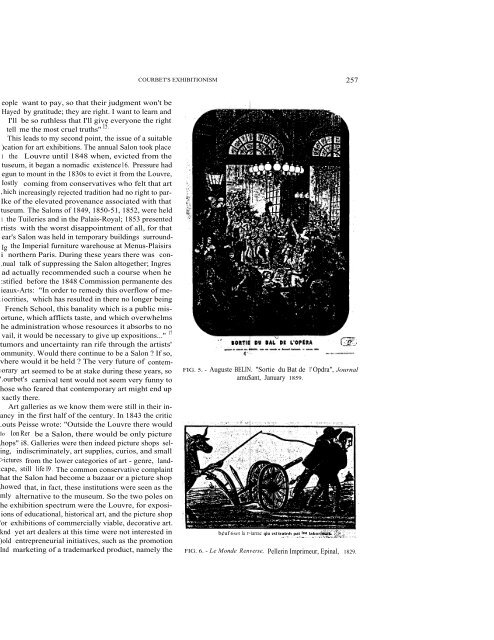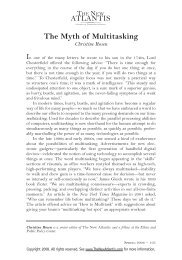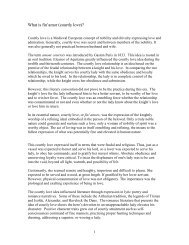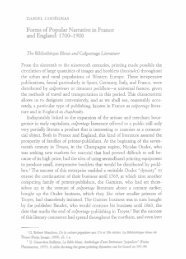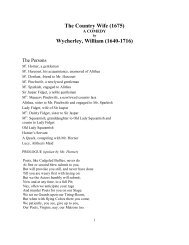Courbet's Exhibitionism
Courbet's Exhibitionism
Courbet's Exhibitionism
Create successful ePaper yourself
Turn your PDF publications into a flip-book with our unique Google optimized e-Paper software.
eople want to pay, so that their judgment won't be<br />
Hayed by gratitude; they are right. I want to learn and<br />
I'll be so ruthless that I'll give everyone the right<br />
15 .<br />
tell me the most cruel truths"<br />
This leads to my second point, the issue of a suitable<br />
)cation for art exhibitions. The annual Salon took place<br />
I the Louvre until 1848 when, evicted from the<br />
tuseum, it began a nomadic existence l 6. Pressure had<br />
egun to mount in the 1830s to evict it from the Louvre,<br />
Iostly coming from conservatives who felt that art<br />
,hich increasingly rejected tradition had no right to par-<br />
Ike of the elevated provenance associated with that<br />
tuseum. The Salons of 1849, 1850-51, 1852, were held<br />
1 the Tuileries and in the Palais-Royal; 1853 presented<br />
rtists with the worst disappointment of all, for that<br />
ear's Salon was held in temporary buildings surround-<br />
Ig the Imperial furniture warehouse at Menus-Plaisirs<br />
i northern Paris. During these years there was con-<br />
,nual talk of suppressing the Salon altogether; Ingres<br />
ad actually recommended such a course when he<br />
:stified before the 1848 Commission permanente des<br />
ieaux-Arts: "In order to remedy this overflow of me-<br />
. iocrities, which has resulted in there no longer being<br />
French School, this banality which is a public misortune,<br />
which afflicts taste, and which overwhelms<br />
he administration whose resources it absorbs to no<br />
vail, it would be necessary to give up expositions..." 17<br />
tumors and uncertainty ran rife through the artists'<br />
ommunity. Would there continue to be a Salon ? If so,<br />
vhere would it be held ? The very future of contem-<br />
>orary art seemed to be at stake during these years, so<br />
'.ourbet's carnival tent would not seem very funny to<br />
hose who feared that contemporary art might end up<br />
xactly there.<br />
Art galleries as we know them were still in their inancy<br />
in the first half of the century. In 1843 the critic<br />
.outs Peisse wrote: "Outside the Louvre there would<br />
Io Ion Rer be a Salon, there would be only picture<br />
,hops" i8. Galleries were then indeed picture shops seling,<br />
indiscriminately, art supplies, curios, and small<br />
>ictures from the lower categories of art - genre, land-<br />
:cape, still life l9 . The common conservative complaint<br />
hat the Salon had become a bazaar or a picture shop<br />
,howed that, in fact, these institutions were seen as the<br />
mly alternative to the museum. So the two poles on<br />
he exhibition spectrum were the Louvre, for exposiions<br />
of educational, historical art, and the picture shop<br />
'or exhibitions of commercially viable, decorative art.<br />
knd yet art dealers at this time were not interested in<br />
)old entrepreneurial initiatives, such as the promotion<br />
Ind marketing of a trademarked product, namely the<br />
COURBET'S EXHIBITIONISM 257<br />
FIG. 5. - Auguste BELIN. "Sortie du Bat de 1' Opdra", Journal<br />
amu$ant, January 1859.<br />
b¢uf 6wt la r~iarrac qiu est tratnh pat lea labor<br />
FIG. 6. - Le Monde Renverse, Pellerin Imprimeur, Epinal, 1829.


